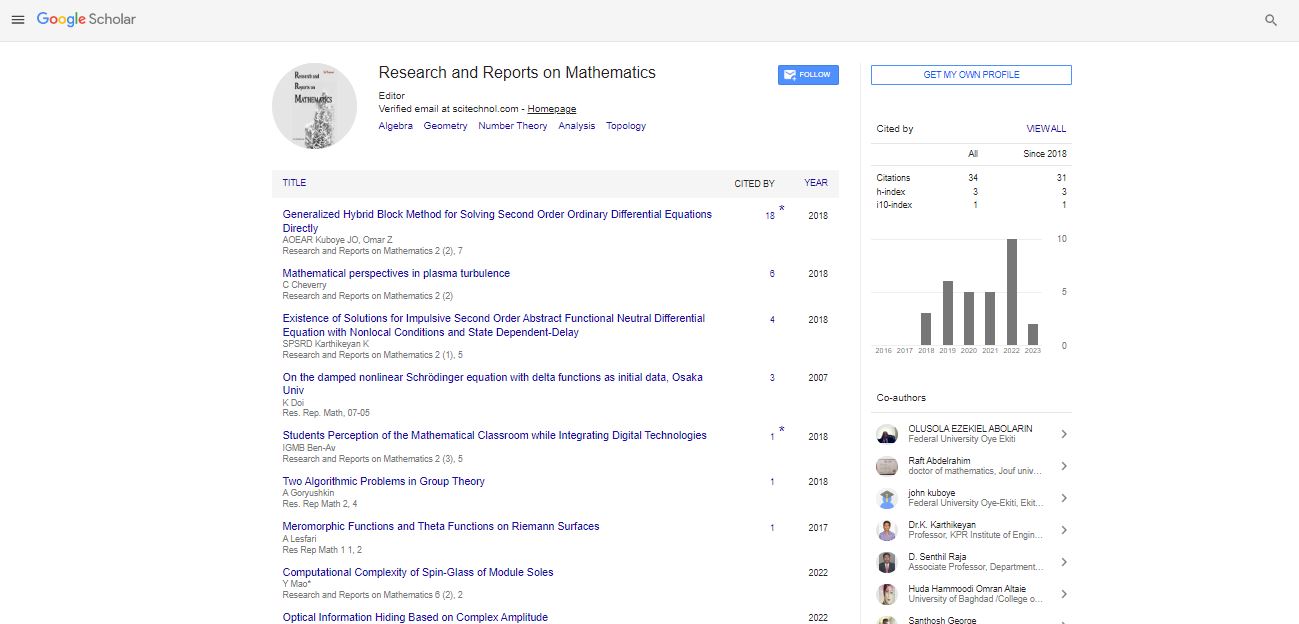Perspective, Res Rep Math Vol: 7 Issue: 1
Investigating the Mathematics behind Neural Networks and Deep Learning
Isabelle Julie*
1Department of Mathematics, University of Paris-Saclay, Batiment Breguet, France
*Corresponding Author: Isabelle Julie
Department of Mathematics, University
of Paris-Saclay, Batiment Breguet, France
E-mail: julie.isa@belle.fr
Received date: 02 February, 2023, Manuscript No. RRM-23-92314;
Editor assigned date: 06 February, 2023, Pre QC No. RRM-23-92314(PQ);
Reviewed date: 13 February, 2023, QC No. RRM-23-92314;
Revised date: 20 February, 2023, Manuscript No. RRM-23-92314(R);
Published date: 27 February, 2023, DOI: 0.4172/rrm.1000171
Citation: Julie I (2023) Investigating the Mathematics behind Neural Networks and Deep Learning. Res Rep Math 7:1.
Description
Neural networks are a type of machine learning model that are inspired by the way the human brain processes information. They consist of multiple layers of interconnected nodes, or neurons, which work together to transform input data into output predictions. The mathematics behind neural networks can be quite complex, but the basic idea is fairly direct. Each neuron in a neural network takes in a set of input values, multiplies them by a set of weights, and then applies a nonlinear activation function to the result. This process is repeated for each neuron in each layer of the network, with the output of one layer serving as the input for the next.
The weights in a neural network are typically learned through a process called backpropagation, which involves adjusting the weights to minimize the difference between the network's predictions and the true values of the output. This process is usually carried out using an optimization algorithm such as stochastic gradient descent. One important mathematical concept that is often used in neural networks is the chain rule of calculus. This allows us to calculate the gradient of the network's error function with respect to each weight in the network, which is necessary for updating the weights during the backpropagation process.
Another important concept in neural network mathematics is regularization. Regularization is used to prevent overfitting, which occurs when the network becomes too complex and begins to fit the training data too closely. Regularization methods such as L1 and L2 regularization add penalties to the network's error function based on the magnitude of the weights, encouraging the network to use smaller weights and avoid overfitting. Overall, the mathematics behind neural networks is a rich and evolving field, with many different techniques and approaches available for building and training effective networks.
Investigating the mathematics behind deep learning
Deep learning is a subfield of machine learning that involves the use of artificial neural networks to learn from large amounts of data. While deep learning models can seem complex and difficult to understand, they are fundamentally based on mathematical concepts and principles. One of the most important mathematical concepts underlying deep learning is linear algebra. In particular, deep learning models rely heavily on matrix multiplication and vector operations. For example, the weights of a neural network can be represented as a matrix, and the input and output data can be represented as vectors.
Another important mathematical concept in deep learning is calculus, particularly optimization. Deep learning models often use gradient descent, a calculus-based optimization algorithm, to adjust their parameters and improve their performance. By calculating the gradient of the loss function with respect to the parameters, the model can iteratively adjust its weights to minimize the loss and improve its accuracy. Probability theory is also essential to deep learning, as many deep learning models rely on probabilistic models to make predictions. For example, Bayesian neural networks use probability distributions to model uncertainty in the input data, allowing them to make more accurate predictions.
Overall, deep learning is a highly mathematical field, and understanding the underlying mathematics is critical to designing and training effective models. However, there are also many high-level tools and libraries available that make it easier for researchers and practitioners to implement and experiment with deep learning models without having to worry about the details of the underlying math.
 Spanish
Spanish  Chinese
Chinese  Russian
Russian  German
German  French
French  Japanese
Japanese  Portuguese
Portuguese  Hindi
Hindi 